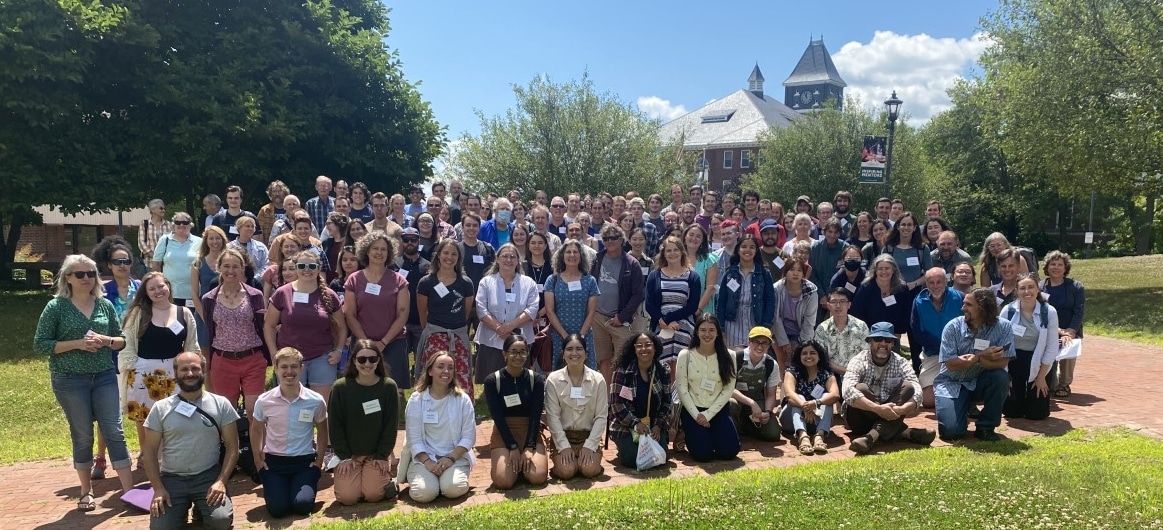
Welcome!
We are a multidisciplinary community of scientists, students, technicians, educators, artists, and environmental leaders contributing to the long-term Hubbard Brook Ecosystem Study. Just as the elements of a forest function as a single, complex ecosystem, the members of the Hubbard Brook community contribute to a whole that is greater than the sum of its parts. We come from a variety of home institutions and backgrounds and our participation in the scientific enterprise at Hubbard Brook can vary over time. We welcome new collaborators, colleagues, and students. Please read more below about how the Hubbard Brook community is organized and how to get involved. Please Contact Us & Visit.
How do things work at Hubbard Brook?
It’s complicated…
Visits to Hubbard Brook, and interactions with long-term project participants can be confusing. A newcomer can feel like they are swimming in a choppy sea of acronyms, history, and assumed information. Here are some points to make this easier:
- The Hubbard Brook Experimental Forest (HBEF) is managed by the USDA Forest Service. They have authority over activities at the site. All new activities at the site must be approved by the Research Approvals Committee (RAC) which includes a mix of Forest Service personnel and other researchers at the site.
- The Hubbard Brook Ecosystem Study (HBES) is the entirety of the research effort at the site. It is led by a mix of Forest Service, university, and other interested individuals working at the site or in the region.
- The Hubbard Brook Research Foundation (HBRF) is an independent, private, non-profit “friends” organization that supports the HBES. They lead science outreach, policy, and education programs and manage housing and laboratory facilities at Mirror Lake and Pleasant View Farm.
- The Hubbard Brook Long Term Ecological Research (LTER) project (HBR) has been funded by the U.S. National Science Foundation (NSF) LTER program since 1988. The project funds much of the long-term monitoring at the site, in collaboration with the Forest Service, grants from the NSF Long Term Research in Environmental Biology (LTREB) program, and other grants from NSF and other agencies. The LTER project is reviewed/renewed by NSF in six year increments.
- The Committee of Scientists (COS) consists of principal investigators conducting research at the experimental forest. The COS gathers during quarterly project meetings and the Annual Cooperator’s Meeting, which are open to all. The Scientific Coordinating Committee (SCC) accepts and reviews nominations for new members of the COS on an annual basis.
- The Scientific Coordinating Committee (SCC) provides leadership for the COS and meets monthly. The SCC has nine members, five of which are elected by the COS. Other members include one of the two Hubbard Brook LTER principal investigators, the USFS Lead Scientist for the Hubbard Brook Project, the Executive Director of the Hubbard Brook Research Foundation, and a non-voting external advisor—a scientist not associated with Hubbard Brook, who is chosen and invited by the other SCC members.
- Other committees include an Information Oversight Committee and an Education and Outreach Committee, which meet annually during the Cooperator’s Meeting to coordinate efforts related to data management, communication, and outreach. These committees are open to all.
- Read the detailed HBES Organizational Plan (2020).
- Check out and contribute to our Guide for Researchers FAQs.
How do I learn what is going on at Hubbard Brook?
Paging through this website is a great way to start. You can sign up for the general Hubbard Brook listserv, maintained by our Information Manager, and our newsletters managed by the Hubbard Brook Research Foundation. Come to our Annual Cooperator’s Meeting in July, or to one of our Quarterly Project Meetings. All are welcome. See the News and Events pages for details.
Be in touch!
Feel free to contact people with scientific and practical questions, and come visit with us at our meetings. Rather than swimming in a sea of confusion, we are hoping people will come and swim in the super nice lake at the site (Mirror Lake)!
